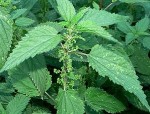 Weeds that hurt you when you are gardening always seem especially threatening and stinging nettles are one of the most common. The stems and leaves of this perennial weed bear hairs that cause a burning sensation when brushed by human skin. The sting doesn’t last long but is painful for a few minutes at the very least. The plant is native to Europe, Asia, and North America and is found in almost every state in the United States. It likes rich, moist, non-acidic soil, and some shade but tolerates a fair amount of sun. It is a common weed in pastures, orchards, gardens, roadsides, hedge rows, woodland edges and stream banks.
Weeds that hurt you when you are gardening always seem especially threatening and stinging nettles are one of the most common. The stems and leaves of this perennial weed bear hairs that cause a burning sensation when brushed by human skin. The sting doesn’t last long but is painful for a few minutes at the very least. The plant is native to Europe, Asia, and North America and is found in almost every state in the United States. It likes rich, moist, non-acidic soil, and some shade but tolerates a fair amount of sun. It is a common weed in pastures, orchards, gardens, roadsides, hedge rows, woodland edges and stream banks.
Stinging nettle is not all bad. It is edible, rich in vitamins and minerals, and is used as a flavoring and to make some delicious food and beverages. Humans are not the only animals that find it tasty and it provides the larval food for several butterflies and moths. Due to its high nitrogen content it can be used to make liquid fertilizer and is a welcome addition to the compost pile. It has also been found to be of value as a companion plant in orchards.
 Description: The erect, branched or unbranched stems grow from 3’ to 7’ tall and bear stinging hairs. The ovate to lanceolate leaves are opposite, toothed, and have sting- as well as non-stinging hairs on their surfaces. As the leaves mature, the number of non-stinging hairs declines. From spring to fall small, inconspicuous green flowers are produced along the stem at the base of the leaf stalks, followed by the formation of seeds in a dry one seeded fruit known as an achene. The root system is bright yellow and consists of rhizomes and stolons that significantly aid the seeds in spreading the plant.
Description: The erect, branched or unbranched stems grow from 3’ to 7’ tall and bear stinging hairs. The ovate to lanceolate leaves are opposite, toothed, and have sting- as well as non-stinging hairs on their surfaces. As the leaves mature, the number of non-stinging hairs declines. From spring to fall small, inconspicuous green flowers are produced along the stem at the base of the leaf stalks, followed by the formation of seeds in a dry one seeded fruit known as an achene. The root system is bright yellow and consists of rhizomes and stolons that significantly aid the seeds in spreading the plant.

 Control: Hand-pulling young seedlings, taking care to protect hands and arms, is a good way of controlling small populations. Rhizomes and stolons must be removed, however, because any that are left in the soil can produce new plants. Mowing can stimulate stem production from the rhizomes and increase plant density. Herbicides containing 2-4-D and glyphosate are effective.
Control: Hand-pulling young seedlings, taking care to protect hands and arms, is a good way of controlling small populations. Rhizomes and stolons must be removed, however, because any that are left in the soil can produce new plants. Mowing can stimulate stem production from the rhizomes and increase plant density. Herbicides containing 2-4-D and glyphosate are effective.